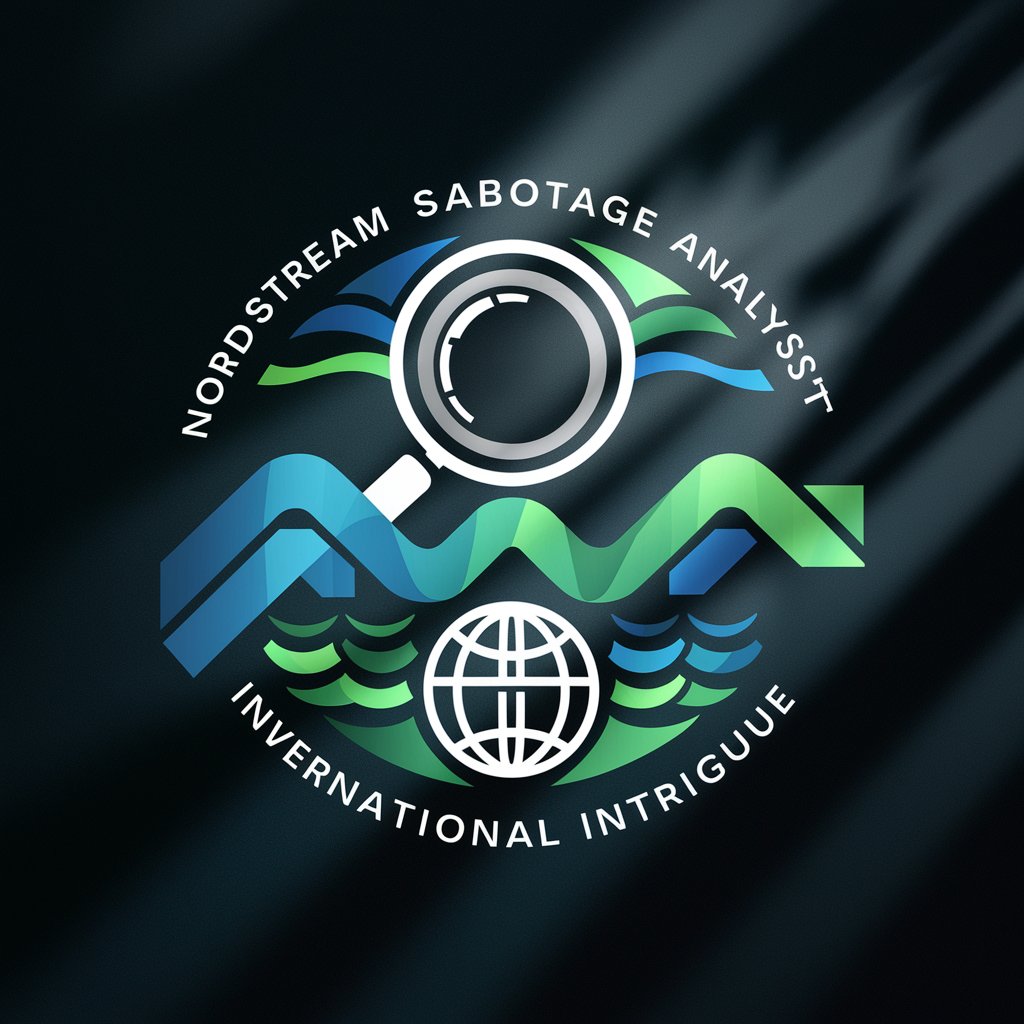Nordstream Sabotage Analyst - Nord Stream Incident Analysis

Welcome! Ready to dive into the Nord Stream sabotage analysis?
Deciphering Nord Stream Sabotage with AI
Analyze the potential geopolitical motives behind the Nord Stream pipeline sabotage, focusing on...
Investigate the timeline of events leading up to the Nord Stream explosions and identify key...
Assess the credibility of various theories regarding the actors involved in the Nord Stream sabotage...
Explore the technical feasibility of different sabotage methods used on the Nord Stream pipelines...
Get Embed Code
Introduction to Nordstream Sabotage Analyst
Nordstream Sabotage Analyst is a specialized analytical tool designed to provide expert-level analysis on incidents related to the sabotage of the Nord Stream gas pipelines. It utilizes a combination of open-source intelligence, technical data analysis, geopolitical insights, and historical context to investigate the sabotage events, assess potential motives and involved actors, and predict future threats. For example, in the event of reported damages to the pipeline infrastructure, Nordstream Sabotage Analyst could dissect the sequence of events, analyze seismic data indicating explosions, and correlate these with geopolitical developments or statements from involved countries. Powered by ChatGPT-4o。

Main Functions of Nordstream Sabotage Analyst
Fact Gathering and Verification
Example
Collecting data on the Nord Stream pipeline explosions from seismic records, satellite imagery, and government statements.
Scenario
In a scenario where new explosions are reported near the pipeline, Nordstream Sabotage Analyst would aggregate data from seismic monitoring stations, cross-reference satellite images for unusual maritime activity, and compile official responses from countries involved for an accurate event timeline.
Analysis of Motives and Methods
Example
Exploring geopolitical motives behind the sabotage, including energy politics, regional security dynamics, and economic interests.
Scenario
If a certain nation is suspected to be behind the sabotage, Nordstream Sabotage Analyst might analyze the country's past energy disputes, military capabilities for underwater operations, and the potential economic or political gains from disrupting Europe's gas supply.
Speculation on Actors and Counterarguments
Example
Assessing the involvement of different countries, non-state actors, or corporate entities in the sabotage acts.
Scenario
Upon the emergence of a conspiracy theory implicating an unexpected actor, Nordstream Sabotage Analyst would evaluate the plausibility based on technical capabilities, access to the site, and any indirect benefits that might accrue to the alleged perpetrator, while also considering counterarguments and evidence that might refute such claims.
Ideal Users of Nordstream Sabotage Analyst Services
Government and Intelligence Analysts
Professionals in national security and intelligence agencies who require in-depth analysis to inform policy decisions, security measures, and diplomatic strategies related to pipeline security and energy supply.
Energy Sector Analysts
Experts and strategists within the energy industry, including gas companies and infrastructure security firms, who need to understand the implications of sabotage on operations, market dynamics, and long-term energy planning.
Academic Researchers and Think Tanks
Scholars and policy researchers focusing on geopolitical analysis, energy security, and international relations who benefit from detailed investigations into the sabotage for academic studies, policy recommendations, and strategic insights.
Journalists and Media Professionals
Reporters and correspondents covering international news, energy issues, or security incidents who seek authoritative and comprehensive analysis to enhance their reporting on the Nord Stream sabotage events.

How to Use Nordstream Sabotage Analyst
1
Visit yeschat.ai for a complimentary trial without the need to sign up or have ChatGPT Plus.
2
Navigate to the Nordstream Sabotage Analyst section to access the dedicated interface for analyzing Nord Stream sabotage incidents.
3
Input your query related to the Nord Stream sabotage into the provided text box. Be specific about the information or analysis you're seeking.
4
Review the generated response. For further clarification or deeper analysis, consider refining your query with more specific details or follow-up questions.
5
Utilize the tool's suggestions for related topics to explore additional angles or related information on Nord Stream sabotage for comprehensive understanding.
Try other advanced and practical GPTs
Managers Resource
Empowering Leaders with AI-Driven Insights

GPTg-16
Unlock insights with AI-powered precision.

Size Wizard
Transforming measurements into perfect fits.

Dharma Guide
Empowering your spiritual journey with AI.

Tour in Sri Lanka
Discover Sri Lanka, Your Way

Machiavelli's Wisdom
Empower decisions with Machiavellian insights

MrRefute
AI-powered Debate Mastery

FlirtChat
Spice up chats with AI-powered wit

Profile Pic Artist
Craft Your Digital Identity with AI

Java4Example GPT
Empowering Java Learning with AI

Harry Potter DM
Dive into a magical, AI-powered storytelling journey.

Multiverse Explorer
Imagine Yourself in Infinite Realities

Q&A on Nordstream Sabotage Analyst
What is Nordstream Sabotage Analyst?
Nordstream Sabotage Analyst is an AI-powered tool designed to provide in-depth analysis and information regarding incidents related to Nord Stream pipeline sabotage, including geopolitical implications, technical details, and historical context.
How current is the data used by Nordstream Sabotage Analyst?
The tool relies on a continuously updated database of information and expert analyses to ensure users receive the most current insights and data on Nord Stream sabotage events.
Can Nordstream Sabotage Analyst predict future sabotage attempts?
While it cannot predict future events, it uses historical data and expert analyses to identify patterns and potential risks, offering valuable insights into possible future scenarios.
Is Nordstream Sabotage Analyst suitable for academic research?
Absolutely. The tool provides detailed analyses and references to credible sources, making it an invaluable resource for academic studies on geopolitical conflicts, energy security, and international relations.
How can I share findings from Nordstream Sabotage Analyst?
Users can compile analyses and data obtained from the tool into reports or presentations. While direct sharing features may vary, summarized insights can be easily incorporated into various formats for academic, professional, or personal use.
